RIGHT TURN ONLY!!
Samurai Dunk
by Carlo Santos,

Lots to cover this week, so let's get right to it!
GAKUEN PRINCE
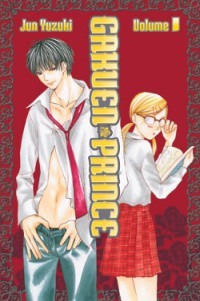
Vol. 1
(by Jun Yuzuki, Del Rey, $10.99)
FROM THE BACK COVER:
"Joshi High is an elite school that most girls in Japan only dream of attending. Then one day everything changes—the all-girl school goes coed. There's just one catch: the girls outnumber the boys. So begins a wild, no-holds-barred competition for the boys of the school. Which smart and independent-minded girl will rise above the fray?"
EVIDENCE FOR:
If you think the cover of this volume is dangerously cheesy, just wait until you see what's inside, which is shocking in its own way. Gakuen Prince is clearly an acquired taste, an intensely dark comedy that perhaps wants to warn us of what really happens when a plain everyday girl (Rise Okitsu) gets together with the hottest guy in school (Azusa Mizutani). The most stunning plot twists so far are the ones where Rise's peers come up with increasingly cruel forms of bullying, pressing each chapter forward as we start to wonder when Rise's going to snap—and indeed she does, in a final chapter that offers at least some catharsis from all the pent-up tension. More unconventional surprises await in the artwork, where the characters frequently contort their expressions into "ugly faces" that add dark emotional intensity along with the usual comedic effect. For an overdone genre, this series sure is twisting it in some really weird ways.
EVIDENCE AGAINST:
It may be a crime to trot out a series laden with dumb, predictable clichés—but to try subverting those clichés by coming up with something intentionally distasteful is even worse. I'm not one to cast moral judgements on works of art and entertainment—for the most part, they are what they are—but a series that seems to glorify bullying, emphasizes the misanthropy between its characters, and then keeps waving it off as "Ha ha! Well that's just shoujo school drama for you!" is seriously messed up. It's not even like it has the thought-provoking, melodramatic ups and downs of LIFE or something; this one is just one constant down ... into a black hole. It's not that badly drawn, aside from obvious bishounen clichés like the shota kid and glasses guy, but everything is so overshadowed by the specter of depravity that you stop worrying about the artwork and start wishing that Rise would just end it all, thus putting herself, and the readers, out of misery. Dysfunctional relationships and people playing screwy mind games with each other are usually good fun, but this one crosses the line.
FINAL VERDICT:
I really hope someone finds a way to enjoy this series. Because personally, I found it so disturbing that it can only score a D.
HIGH SCHOOL DEBUT
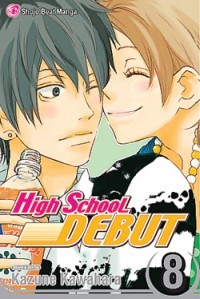
Vol. 8
(by Kazune Kawahara, Viz Media, $8.99)
FROM THE BACK COVER:
"Hapless Haruna needs help finding a boyfriend! After failing to win the eye of any guy in high school, Haruna enlists the help of cute upperclassman Yoh to coach her on how to make herself more appealing to the male species. Yoh agrees, with one catch: Haruna had better not fall for him!
Yoh's worried that a freshman seems to have the hots for Haruna, but Haruna is as oblivious as ever. So when the boy in question makes a move on Haruna, how will she respond? More importantly, how will Yoh react?"
EVIDENCE FOR:
The answer to that is easy! Haruna responds ... hilariously. Yoh reacts ... Yoh-ishly. And Kazune Kawahara turns in two chapters of absolute comedic genius, devising some of the funniest gags since those early chapters when Haruna was still trying to pick up guys. Apparently, freshman cooties make you do all sorts of funny things, like Haruna's attempts to "disinfect" herself, to her complete and utter state of being IN DESPAIR!!, to Yoh's blank-faced looks, and finally, one of the funniest kiss scenes ever staged in any series anywhere. It's almost enough to make you forget the romantic part of romantic comedy, but that comes as well in the final chapter, which turns out to be Haruna's birthday. As usual, all of this is rendered in effortless artistic style, where the layouts provide plenty of room to breathe, the characters express themselves in lively and distinctive ways, and the key emotional scenes are always worth lingering on for an extra second because they're just so sweet. And the greatest accomplishment, perhaps, is that this volume can bounce between the downside and upside of couplehood and still make you smile no matter what.
EVIDENCE AGAINST:
Is it true that all romance series go downhill once the main couple gets together? Looking at the big picture, it may seem that way: the first half of this volume, funny as it may be, is yet another iteration on the standard "some person gets in the way of Haruna and Yoh" that has been plaguing them since, oh, Volume 5. Seriously, we've been through Haruna's former rival, Yoh's ex-girlfriend, the new students at school, what next? Creepy old man on the train? Then there's the mind-numbing boyfriend-girlfriend bliss of the birthday arc, which somehow spends a chapter and a half going nowhere: Yoh is hemming and hawing about what to get for Haruna, and she's trying to anticipate what he's going to do, and they waste 60-70 pages on this. Come on, just have a birthday date already. (They do, by attending a totally unrealistic baseball game.) The artwork can suffer from bouts of plainness as well, as the consistently rectangular panels and backgroundless dialogue scenes start to wear out the eye after a while.
FINAL VERDICT:
Fact: that birthday storyline took way too long. Also a fact: still can't stop being amused by what Yoh did to that freshman. So this volume gets a B+ nonetheless.
MAID SAMA!

Vol. 1
(by Hiro Fujiwara, Tokyopop, $10.99)
FROM THE BACK COVER:
"The class president has a little secret she's been keeping from the sexy bad boy in school...
As President of the Student Council, the overachieving feminist Misaki really socks it to the guys in an attempt to make the former all-boys' school attract a more female student body. But what will she do when the hottest boy in class finds out Misaki's after-school gig is in a maid café?!
It's love at first sight in this shôjo romantic comedy—with a whole new look at the battle between the sexes!"
EVIDENCE FOR:
I want to hate this series, but I just can't. Despite its otaku-tastic premise and blatantly obvious boy-girl pairing, the sheer energy of Maid Sama! makes for a zesty, fresh-tasting product. First off, Misaki actually stands up for herself and isn't afraid to piss off others—a nice change from the passive good-girl types—plus her over-the-top work ethic is absolutely magnetic (is it any surprise that Chapter 4 is about a troupe of fanboys who start idolizing her). Then there's resident bishounen Usui, who instead of being just the obligatory bastard-who-occasionally-does-nice-things, seems genuinely interested in Misaki and can be insightful from time to time ("If you're always so antagonistic toward boys, they'll start being antagonistic toward you"). Aside from this quirky relationship, there's also the amusing spoof of maid subculture—check out the omake on how Misaki got the job—plus a poignant one-shot proving Hiro Fujiwara's talent. And yes, this series really is a shoujo, as proven by the numerous maid scenes with nary a pantyshot or fanservice illustration in sight.
EVIDENCE AGAINST:
So, the character chemistry and comedy factor is better than the plot summary suggests. Now what's the catch? For starters, it goes entirely through the motions of the average school comedy, shoving in a school festival as early as Chapter 2 (and of course the class puts on a café, like 90% of all fictional high schools in Japan) and other sorts of episodic drivel like "Usui saves Misaki from maid café stalkers" and "Usui makes a really stupid but noble sacrifice." For visually inclined readers, however, the real drawback of this volume might be the haphazard sense of layout where Fujiwara draws whatever she likes, wherever she likes, and then tries to shove in the dialogue wherever possible because the characters are talking all the time. There are maybe one or two truly eye-catching moments to be found here—a dramatic declaration of love, a shot of Usui with his shirt ripped open—but the rest of the art is just boring old high school scenery with way too much chatter.
FINAL VERDICT:
Still more fun than being punched in the face with mediocre shoujo, and the characters are pretty entertaining. It's a C+ but with possible upside if the plot (or the artwork) starts to improve.
SAMURAI 7
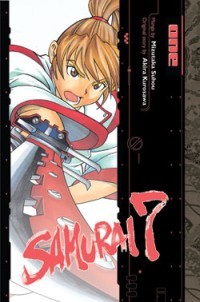
Vol. 1
(by Mizutaka Suhou, original story by Akira Kurosawa, Del Rey, $10.99)
FROM THE BACK COVER:
"Threatened by plundering cyborg bandits, an innocent village defies its inhuman enemies with the help of mortal men born to do battle and bound to die for honor: humanity's champions, the seven samurai. This thrilling manga is based on the classic film by Akira Kurosawa."
EVIDENCE FOR:
Are you ready to be visually impressed? Because Samurai 7, which ties in to the sci-fi-meets-historical anime of the same name, is ready to deliver a powerful artistic punch. Otherworldly landscapes, outlandish mechanical designs and exotic weaponry are the calling card of this series, proving that an adaptation of an adaptation need not be a trashy low-budget affair. Best of all, Mizutaka Suhou knows how to get the most out an action scene, using cinematic pacing (yes I know that word gets used all the time but here's someone who actually knows how to do it) to enliven moments as simple as a "samurai test of reflexes" or as grand as taking down an entire battleship. Speaking of taking down battleships, the futuristic weaponry has a knock-on effect that makes everything else around it better: battling mechanical baddies with a gun/katana/lightsaber hybrid pretty much forces everyone to come up with a highly creative fighting style. Just as creative are the characters themselves, who are instantly appealing and include—among other things—a dismembered cyborg head. Did Kurosawa ever have a dismembered cyborg head? Didn't think so.
EVIDENCE AGAINST:
The flowing action and varied characters may be an instant hit, but the story itself is probably going to live and die by its own slavish adherence to the original. Throw in all the sci-fi imagery and robot warriors you want, but it's hard to get excited about a plotline where every key point is patently obvious: village cries out for help, various samurai are summoned together, samurai embark on journey to save village. Also rather predictable is the campy selection of warriors, which pulls from all sorts of well-worn tropes: the kid, the war veteran, the fat guy, the dandy, the ... dismembered cyborg head (okay, so maybe that one's a little more unconventional). Also, Suhou's artistic style may also be a little too clean and sterile for its own good: sure, it makes the reading a lot faster and easier, but those speedlines are so obviously computer-generated, and dust and dirt apparently don't exist. A little more grit, a little more grime, and maybe it would truly capture the frontier atmosphere of a far-future samurai world.
FINAL VERDICT:
A little too conventional and clean-cut in some ways, but still worthy of a B for delivering what all good samurai stories should: a thick, satisfying dose of sword-swinging action.
SLAM DUNK

Vol. 3
(by Takehiko Inoue, Viz Media, $7.99)
FROM THE BACK COVER:
"Winning isn't everything in the game of basketball, but who wants to come in second? It takes dedication and discipline to be the best, and the Shohoku High hoops team wants to be just that. They have one last year to make their captain's dream of reaching the finals come true—will they do it? Takehiko Inoue's beloved basketball manga is finally here and the tale of a lifetime is in your hands.
For a self-proclaimed genius such as Sakuragi, executing a dazzling slam dunk is no problem at all, but what about some other basketball moves that require a bit more finesse? With the help of Haruko (and some goading from captain Akagi), Sakuragi attempts to put his pride in check and learn how to pull off a basic layup. In theory it should be easy ... but sometimes the simplest shots are the toughest to master."
EVIDENCE FOR:
Takehiko Inoue may very well be the Tim Duncan of manga—not quite as famous as Tite "Kobe" or Masashi "KingJames"moto, but always getting the job done with terrifying consistency, page after page, panel after panel. Here's a guy who can wow you with heartstopping sports-action illustrations or pull you into the rhythm of everyday high school conversation—it really doesn't matter what stage the story's at, because Inoue finds a way to keep readers hooked. The highlight of this volume, though, is seeing Slam Dunk's sense of humor come alive: Sakuragi's struggles with the layup are a guaranteed laugh riot for any hoops fan (cue the whistled strains of "Sweet Georgia Brown"), his blustery encounter with an opposing team's scout is unbridled arrogance at its best ("Do I look like Rukawa to you, you monkey?!"), and even getting suited up for the game becomes an exercise in slapstick when Sakuragi insists on having his own numbered jersey. Distinctive facial expressions and a sure-handed sense of line make every page a pleasure to read—whether you're a basketball fan, manga fan, or just want to be entertained.
EVIDENCE AGAINST:
So, when are they going to start playing some actual basketball already? The first few chapters of this volume provide a teaser with Sakuragi's comical training scenes, plus some gorgeously drawn full-page spreads, but the momentum starts to drop as soon as things turn back to dialogue and other non-basketball activities. Yes, it is wonderful and exciting that Shohoku is finally scheduled to play a proper exhibition match, but for Inoue to drag the pregame preparations to the end of the volume is absolutely maddening (kind of like how Duncan and the Spurs can only seem to win a championship every other year, thus derailing the concept of a team dynasty). And funny as Sakuragi's personality is, he does start to get kind of monotonous—yes, we get it, you think you're God's gift to basketball. Now let's get back to the character dynamics involving Akagi, Rukawa, and Haruko as well, because team effort is the way to sporting success.
FINAL VERDICT:
It lags on the pacing a bit—just hurry up and play a game already!—but for the sheer joy of watching Sakuragi mince about on the court with his infectious attitude, it still earns a B.

WOLVERINE: PRODIGAL SON
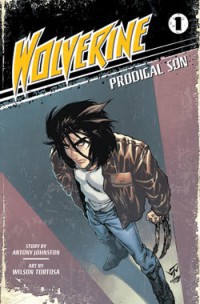
Vol. 1
(by Antony Johnston and Wilson Tortosa, Del Rey, $12.99)
FROM THE BACK COVER:
"This is not the Wolverine you know.
Logan is a teenage rebel with a real good reason for having a real bad attitude. Ever since being left in a nearby forest—with no memory of who he was or how he got there—Logan (or Wolverine, as his classmates sometimes call him) has been stuck in a martial arts school in the icy wilds of Canada. No wonder he's bored, restless, yearning. There's a whole world out there, and Logan can almost taste it. But he's chained to a past he can't remember and can't escape. Now it just may destroy his future."
EVIDENCE FOR:
Now this ... this is a superhero origin story that bristles with youthful rage! Sure, maybe it's just Logan being the whiny basket case that he is, but by the halfway point he's got all the reasons in the world to be upset: everything he's ever known and loved is being destroyed and there are some seriously evil dudes after him. Dramatic motivation doesn't get much better than that, and the outpourings of rage and vengeance—especially in the climactic showdown between Wolvie and a former rival—power this story to a strong finish. Much of that strength also comes from the bold artwork, which delivers action almost nonstop with speedlines and hatching, and only becomes more intense (if such a thing can be imagined) as Logan's foes become increasingly powerful. But Wilson Tortosa is not the kind of artist who only knows how to draw one thing; his portrayals of the Canadian wilderness and the bustle of New York also combine with the action to form a complete reading experience. It's vivid, it's violent, and it'll have you flipping the pages.
EVIDENCE AGAINST:
I don't know why superhero publishers keep doing it (and technically, this is Del Rey licensing a Marvel character, but still), but why must every "manga interpretation" of their characters involve rampant Japanophilia? Although not as overt as Batman: Death Mask, this story still cheeses out and brings in elements like martial arts as Logan's fighting background and ninjas as his pursuers. Or maybe I'm just reading too much into stuff like this (at least they didn't write "snikt" in katakana). The real downfall of this volume, though, is how it tries to do that whole "epic story in 150-180 pages" thing, which never quite works, leading to a shallow and rushed first half—Logan whines pubescently, goes out on contrived training exercise—and a finale that tells us, in not so many words, "The adventure is just beginning!" Yes, yes, it definitely is. Oh, and a quick word to Mr. Tortosa: Screentones. Hatching. You don't have to draw everything. Same thing I tell everyone.
FINAL VERDICT:
Actually ... my favorite X-Men character is Gambit. I always thought Wolverine was "just okay." But the action here is blistering, the emotions are raw and real, and for many that's all the reason you need to check it out.

Guilty pleasures, we've all got 'em! This week, Lianna Mills knows where it's at as she picks one of my personal favorites! Everyone else, keep sending yours in, because the best way to get over guilt is to confess. Ain't that right?
SHUGO CHARA!
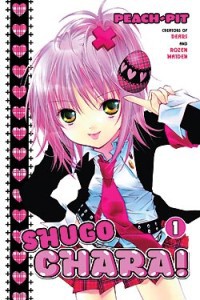
(by Peach-Pit, Del Rey, $10.95 ea.)
When you mentioned guilty pleasures, Shugo Chara! immediately came to mind. I mean, I'm a grown woman, someone who prefers shonen action series to sickly-sweet shoujos, and yet I can't seem to not like Shugo Chara!, a magical girl series for elementary school girls. Actually, I can't help but love it.
Shugo Chara!'s heroine is Amu Hinamori, an elementary school girl who has trouble being herself. She wishes to be reborn as her "would-be self," and the result is more drastic than she expected: the next morning, Amu appears to have laid three extremely colorful Easter eggs in her sleep. They end up hatching into Guardian Characters, little angel-like beings that are there to help her change. Of course, Amu is given a lock that she can use to change into a super-powered, frilly-costumed, butt-kicking alter ego, or rather three alter egos, depending on which Guardian Character she uses. Once transformed, she can use her powers to battle and purify X-Eggs and X-Characters, which are basically Guardian Characters and their eggs that have gone bad because the heart that created them was exposed to negative energy or emotions. Amu also has about a billion crushes, though the major love interests seem to be Tadase, a kid who also has a Guardian Character and dreams of ruling the world (no comment), and Ikuto, this cat guy who is supposed to be her enemy. And he's in high school. And she's in elementary school. Ahem.
Though Peach-Pit's interpretation of the magical girl genre is pretty different from the typical Sailor Moon-style "girl transforms and defeats enemies with help of fuzzy mascot", nothing really changes much. Amu uses a special phrase and a necklace to transform, and when she is transformed she wears ridiculous, overly-frilly costumes whose themes come from the talent of the Guardian Character she transforms with. She chases, battles and purifies X-Eggs and X-Characters in a very monster-of-the-week sort of way most of the time, and fights with ridiculous objects and attacks (such as a giant paint brush and the recurring "Open Heart" "attack"). None of the enemy's henchmen are ever defeated completely, and end up joining up with Amu and the gang once their master plan fails, touched by her pure heartedness, or something like that.
The art work is pretty good, I have to say. Amu's punk goth-style clothes are suitably cute and well detailed, as are all of her transformation's ludicrous costumes. No trouble should be had with telling characters apart, which is a good thing. All of the Guardian Characters are pretty well designed and have outfits that match their personalities and transformations. Everyone wears very trendy clothes, or what must be trendy in Japan, at least (the clothes are actually kind of hideous). I personally find the shoujo embellishments made to virtually every page a bit suffocating; sparkles or flowers or little hearts are all over the place.
In all, I really don't know why I'm so obsessed with such a girly series. Almost all of the characters have one-note personalities, the plot's campy and pretty meaningless, and it's oppressively shoujo. And yet, I own every volume released in the States and have the next one on pre-order from Amazon. It must be some kind of sickness.
Is there a hidden gem of manga you'd like to reveal to the world? Is there a piece of garbage that deserves to be bashed in public? Or is there a title that didn't get a fair grade here, and you want to set the record straight?
Now's YOUR chance to be the reviewer! Write a review of about 300-400 words (a little more or less is fine) and include:
- Your name
- Title of manga (and volume no., if applicable)
- Author/Artist
- Publisher
- Briefly describe the story, then explain why this manga is great, terrible, or in between. Be objective, but also be entertaining.
Then send it in to rtoreaders (at) gmail (dot) com (plain text is recommended). One review will be selected out of all the submissions and will be published in the next column. All types of manga and manga-inspired comickry are accepted, from past and present, from Japan and beyond—what matters is that it's the Reader's Choice! NOTE: Submissions may be edited for formatting and grammar.
discuss this in the forum (14 posts) |